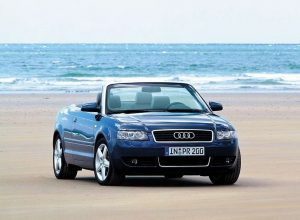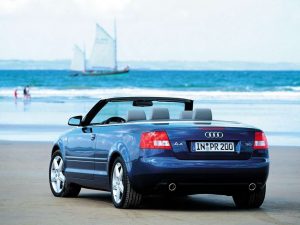Recalls: Audi B6 A4 Cabriolet
Overview
Manufacturers, or importers, issue recalls for defects or faults which have the potential to cause injury. Generally, manufacturers will inform the original buyers if their vehicle is subject to a recall and of the steps required to remedy the defect or fault. Please note that the recalls below (if any) are for Australian-delivered vehicles only. Furthermore, the number of recalls should not be taken as an indication of a model’s reliability or its safety more generally.
Recalls: Audi B6 A4 Cabriolet
Audi B7 A4 Cabriolet with xenon headlights: reflectors to be replaced
In July 2005, a recall was issued for Audi B6 A4 Cabriolet vehicles fitted with xenon headlights so that the reflectors could be replaced since the brightness of the original reflectors could decline over time (PRA 2005/7898).
Audi B6 A4 Cabriolet: Takata airbag recall
In August 2018, a recall was issued for Audi B6 A4 Cabriolet vehicles. The Takata driver’s airbag in these vehicles contained propellant wafers that could absorb moisture over time. In the event of a collision which triggered the driver’s airbag, excessive internal pressure could cause the metal airbag inflator housing to explode. This, in turn, would cause the metal fragments to be projected through the airbag cushion and into the cabin – these fragments posed a serious risk of injury and fatality. For the VINs of the recalled vehicles, please see PRA 2018/16949.
Problems and faults: Audi B6 A4 Cabriolet
Overview
This section identifies potential problems, causes and fixes based on the experiences of owners and repairers, online sources and technical service bulletins. This information is provided solely for reference purposes and AustralianCar.Reviews recommends that only properly qualified persons carry out repairs or modifications. Furthermore, the number of items below should not be taken as an indicator of a model’s reliability or the frequency with which they may occur.
To report a problem or fault to the AustralianCar.Reviews team, please use the Contact Us form. Note that AustralianCar.Reviews does not offer advice on automotive problems or disputes; such enquiries will not receive a reply. For vehicles purchased from dealers after 1 January 2011, please see our Australian Consumer Law fact sheet.
Audi B6 A4 Cabriolet 1.8T and 3.0 V6: misfires and ignition coils
In December 2006, Audi issued technical service bulletin 2013623/1 for 2005-06 Audi B7 A4 Cabriolet vehicles with 1.8T or 3.0 V6 engines. In these vehicles,
- The Malfunction Indicator Light (MIL) may be flashing or constantly illuminated; and,
- Diagnostic Trouble Codes (DTCs) for misfire in one or more cylinders (P0300 to P0312, depending on the engine) are stored in the Engine Control Module (ECM).
According to the service bulletin, the misfire could be caused by the ingress of moisture in the ignition coils. Furthermore, new ignition coils supplied by Powertrain Pulse ERA were installed in production.
Audi B6 A4 Cabriolet Multitronic: emergency running mode and DTCs
In May 2007, Audi issued technical service bulletin 2012154/8 for 2003-06 Audi B7 A4 Cabriolet vehicles with 01J continuously variable transmissions (CVTs, Audi’s ‘Multitronic’). In these vehicles,
- The Malfunction Indicator Light (MIL) may illuminate;
- The vehicle may enter emergency running mode with gear indicator illumination inverted; and,
- Diagnostic Trouble Codes 17090-P0706 (transmission range sensor circuit range/performance) or 18201-P1793 (output speed sensor 2 circuit no signal) may be issued.
If either of the above Diagnostic Trouble Codes (DTCs) were logged, the Transmission Control Module was to be replaced.
Problems and faults: Audi B6 A4 Cabriolet
- The anti-lock braking system (ABS) may activate unnecessarily under normal to light braking pressure due to cracks in tone/exciter rings (rings on the outer CV shaft that measure wheel rotation).
- When the oil filter is removed, the oil cooler is susceptible to turning – this may damage the coolant lines and cause a coolant leak.
- For the 1.8-litre turbocharged petrol engine, the throttle body control valve may sludge up, causing a very low or uneven idle.




